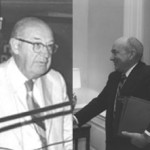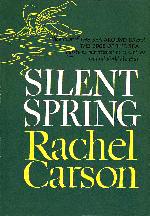In the 1950’s entomologists discovered that insects were developing resistance to pesticides because of their overuse and abuse. Environmentalists were concerned about the damage and danger of pesticides to the environment. In the 1960’s Rachel Carson‘s book Silent Spring alerted the public to problems with pesticides.1
The concept and impetus for IPM grew out of the discontent with using a purely insecticidal approach to insect control in many areas in the 1950’s. Overuse of insecticides resulted in insects that were resistant to insecticides, resurgence of pests after treatment and occurrence of secondary pests that became a problem only after the natural enemies that had been keeping them in check were killed by insecticides. “Integrated control” was developed emphasizing use of selective insecticides so that natural enemies were conserved in the system. This integration of control techniques was expanded in later years to include other management options such as resistant crop varieties, crop rotation and other tactics and to include weed and diseases as pests in addition to insects.
What began 30 years ago as a lofty notion to partner with nature when controlling pest problems has blossomed into a nationally accepted practice that saves the environment, money, and reduces pesticide use.

Drs. Perry Adkisson and Ray Smith, co-recipients of the 1997 World Food Prize, were among the first to note the harmful environmental and economic effects of indiscriminate synthetic chemical pesticide use.
This new approach, termed Integrated Pest Management or IPM, applies a holistic solution to the problem of managing harmful insects, weeds and plant diseases. Dr. Perry Adkisson (Texas A&M University) and Dr. Ray Smith (University of California) were among the first to deduce that most plant diseases, weeds, insects, and other pests could be controlled by employing good crop management practices and maximizing the many controls already existing in nature.
Dr. Tom Fuchs, coordinator of the Texas IPM program for the Texas AgriLife Extension Service, called IPM a favorable alternative to the rampant overuse of chemical pesticides occurring at the time.
According to Dr. Fuchs, the overuse of pesticides was not only killing pests, but also the natural enemies of pests, upsetting one of nature’s own systems to keep pests in check. While pesticides remain a part of IPM, the products least toxic to humans and beneficial organisms are preferred and pesticides are used only when necessary.
IPM came to Texas in an organized way in 1972, when four AgriLife Extension pest management agents began to work with producers year-round in cotton producing regions of the state. With the success of the cotton IPM programs, sorghum and peanut programs were soon added. Soon crop producers across the state were converts, using natural enemies, crop rotation, planting dates, and other biological and mechanical controls to manage pests in many different commodities.2
1Source: Texas IPM Foundation
2Source: Texas IPM
Next >> IPM Concepts

